
Introducing your child to their first balance bike can be a joyous moment for parents. These pedal-free little toys are the new superheroes on the block when it comes to teaching your child how to ride a bike the right way.
We make no secret here at ilovetoridemybike.com that we think they are the best toy available to begin teaching kids the fundamental bike riding skills such as balance, coordination, and not to mention, provide a bucket load of confidence for your little gem as these wonderful little toys help to make the transition to a pedal bike seamless.
But with so many options available, it can be overwhelming for parents to choose the right one.
Rest assured, we are here to help. So that you can make an informed decision, we have put together 10 things parents should know before buying a balance bike for your child.
Affiliate disclosure time: Some of the links on this page are affiliate links. If you click on those links and make a purchase within a time frame, we earn a small commission. Rest assured, the commission is paid by the retailers, not by you.
This commission helps keep ilovetoridemybike.com riding and writing. We thank you for your generous support. You are helping us continue doing what we love and that’s provide our customers with all the information they need to know about balance bikes for kids.
10 things parents should know before buying a kid’s balance bike
1. Is Your Child Ready to Ride?
First up, how do you know if your child is ready to ride? To help you answer this question, we are going to ask you another important question.
Is your child walking confidently? If the answer is yes, then they are ready to begin taking their first steps (pardon the pun) on a bike.
But which bike is best at this age?
At around 12 months, your child is tiny. So, we need a tiny bike option to accommodate their little bodies. Therefore, we recommend for the youngest of riders aged between 12-18 months an option called baby balance bikes, aka toddler bikes or ride-on-toys.
These little bikes usually have a more stable quad-wheel design, some seat adjustability and plastic wheels best suited for indoor use.
*** Note: These ride-on-toys are not the same as a kids balance bike (see below).
They are designed to allow your child to have a more stable seated position, while encouraging toddlers to begin using their legs to push off the ground and get them rolling, just like we want them to do when introduced to a balance bike at around 18+ months of age.
Our recommendation is to begin your little rider on a ride-on-toy rather than a tricycle or bike with training wheels. The correct skills of balance and stability begins with the right toys to facilitate these skills. Ride-on-toys will do this perfectly well prior to their balance bike progression.
Training wheels and tricycles do not allow toddlers to develop the correct skills of balance, coordination and steering and are counterintuitive to the correct way to learn how to ride. Therefore, these and are not recommended.
Some perfect ride-on-toys aka baby balance bike options available for toddlers 12-18 months include the Chillafish Quadie, GOMO Sprout Flip, Radio Flyer Scoot to Scooter, YBike Pewi Stroll, Crocco Ultra, and Chestnuter Baby Balance Bike.
Once your child is around 18 months, we recommend that you introduce your child to what is called a kid’s balance bike.
The most popular wheel size for kids balance bikes begins at 12″, but there are a few smaller wheel size options available such as on the Kinderfeets Tiny Tot 2-in-1 balance bike, Y-Velo Junior 9″ balance bike and the Bobike toddler balance bike.
2. Your Child’s Inseam Height
Ok, so your little rider is off and riding and has progressed or is about to begin riding a kid’s balance bike. Like we mentioned earlier, the most popular balance bike wheel size is 12″.
This is usually the best size to begin learning how to ride a balance bike from around 18+ months, and the manufacturers provide some amazing features, depending on your budget, for the 12″ bikes.
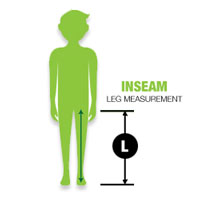 That being said, balance bikes, unlike adult or kid’s bikes, do not have a one-size-fits-all design. The 12″ balance bike market varies widely in features and more importantly, if they will fit your little rider at all.
That being said, balance bikes, unlike adult or kid’s bikes, do not have a one-size-fits-all design. The 12″ balance bike market varies widely in features and more importantly, if they will fit your little rider at all.
Variables such as age and height do need to be taken into consideration, yet the number one piece of information parents need to know before purchasing a balance bike is your child’s inseam height.
If you are unsure what this is, or how to find your child’s inseam, head on over to our post, Balance Bike Buyers Guide.
In that post we outline what determines a balance bike’s size, how to find your child’s inseam, optimal seat height, how to use this information to go balance bike shopping and some additional features for you to consider when purchasing a balance bike.
Once you know your child’s inseam height, subtract 1″ to 1.5″ from this to determine your child’s optimal seat height.
Perfect!
Now here’s one further tip. Yes, you may have just calculated your child’s optimal seat height, but here’s one additional practical check you can make. When seated, your child’s feet should be flat on the ground with a slight bend at the knees.
Now using this optimal seat height, you want to ensure this falls toward the lower end of the seat height range of the balance bike you are looking to purchase.
Let’s take a look at a quick example of a kids balance bike, the Strider 12 Sport to help you get the picture.
Example Rider
Inseam Height: 14″
Optimal Seat Height: 13″ (14″ – 1″ = 13″)
Strider 12 Sport Seat Height Range: 11″ – 19″ (optimal seat height of 13″ falls nicely toward the lower end of this range)
Looking at the above example and information, the Strider 12 Sport balance bike would be a great fit for a child with inseam height 14″.
Now let’s take a look at a few more important things we need to consider before making our purchase.
3. Seat Height Range and Adjustability
As you have just seen with the above example, the seat height range determines if a balance bike will correctly fit your child.
Fundamentally, a balance bike seat height range is the amount of seat adjustability available.
Most balance bikes will have some seat height adjustment capabilities. Others, such as on the example we used above on the Strider 12 Sport, will have a huge amount of seat height adjustment.
This feature is very helpful as it allows your child to grow and continue to ride the same balance bike for years to come. As a guide, if your child’s optimal seat height falls toward the lower end of the balance bike’s seat height range, they should get around 2+ years of riding on the bike before wanting to progress to a bigger bike.
One final note here is worth mentioning.
Toddlers at this age grow like mushrooms. Therefore, you will find yourself needing to adjust the seat height quite regularly, so it’s super helpful to be able to do this quickly and easily.
Balance bikes generally have two clamp types that secure a seat post. Single bolt (tool required) seat post clamps or quick release (tool-free) clamps (see images below).
Quick release (tool-free) clamp
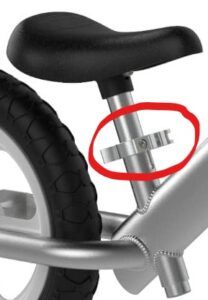
Tool required seat post clamp!
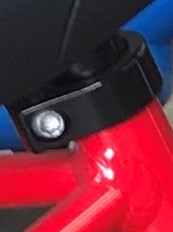
We absolutely recommend purchasing a balance bike with quick release seat post clamps as these are easy to use and make adjusting the seat height child’s play.
Some better examples of balance bikes with excellent seat height range and quick release clamps include the Norco Runner, Cooghi, Cruzee, Strider 12 Sport and Strider Classic, and Vuly.
4. Bike Weight
When it comes to choosing the right balance bike for your child there is another key feature that’s important to get right.
Bike weight. But why?
Well, quite simply the lighter the bike the easier it will be for your child to maneuver, control and manage as they learn the fine art of bike riding.
A bike that is super light will make this process easier and more fun. As an added bonus, a light bike is less demanding for us (yep myself included) parents out there to carry when your little gem has had enough for the day 🙂
Luckily, there is a simple rule to follow when considering bike weight. A balance bike should not weight more than 30% of your child’s weight.
Let’s take a look at a practical example to make this easier to understand and implement.
Example Rider’s Weight: 12.5kgs
Maximum Balance Bike Weight: 3.75kgs (0.3 multiplied by 12.5kg = 3.75kg)
Now taking this one step further, let’s take a look at the weight of a few balance bike’s on the market, to see which will be suitable for our example rider who weighs 12.5kgs (maximum bike weight of 3.75kgs).
| Balance Bike | Weight (kgs) | Suitable Bike
Yes / No |
| Strider 12 Sport | 3 | Yes |
| Cruzee | 1.9 | Yes |
| Chillafish | 2.5 | Yes |
| Strider 14X | 5.7 | No |
| Banana GT | 3.7 | Yes |
| Kriddo | 3.6 | Yes |
| GOMO | 3.2 | Yes |
| Bixe 16 | 6.8 | No |
| Cooghi | 3.1 | Yes |
| Lava Sport | 2.9 | Yes |
You can see from the above table, that most, yet not all balance bikes will be suited for our example rider when it comes to bike weight.
So just be sure to follow the above rule and check both your child’s and the balance bike weight before parting with your hard-earned cash.
5. Tire Options
When it comes to comfort and safety on a balance bike, tire choice is essential.
Balance bikes generally have two choices available when it comes to tires. EVA solid foam or air (pneumatic) tires.
EVA Foam Tires
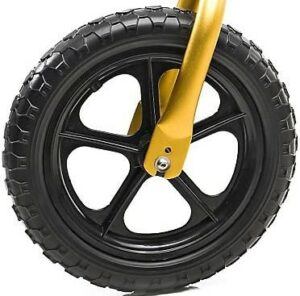 The majority of balance bikes on the market come with EVA foam-filled tires. These are lighter than air tires and are maintenance free. For an example, see the Cooghi balance bike.
The majority of balance bikes on the market come with EVA foam-filled tires. These are lighter than air tires and are maintenance free. For an example, see the Cooghi balance bike.
This lighter, foam-filled tire however won’t provide the same level of suspension, comfort or control as it’s air-filled rival, especially on off-road surfaces.
That being said, if your child usually sticks to hard surfaces, indoor gyms or grass then these tires will serve your little rider well.
Air (pneumatic) Tires
Air filled tires provide superior comfort, suspension and traction on any surface.
If your child is the more adventurous type who likes to get off-road onto gravel, dirt and all-terrain bike parks then we absolutely recommend air tires for your little rider.
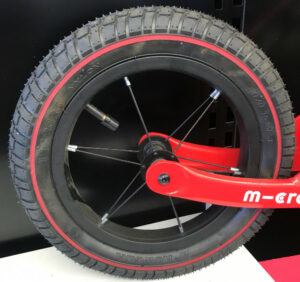 Keep in mind that air tires do require regular maintenance to ensure adequate air pressure and at times, a replacement tube.
Keep in mind that air tires do require regular maintenance to ensure adequate air pressure and at times, a replacement tube.
That being said, our recommendation is to purchase a balance bike with air tires if this is within your budget. Your child’s level of comfort and fun experienced on their bike will thank you for it.
Some great examples of highly recommended balance bikes with air tires include the Vuly, Norco Runner, Cooghi S4, smarTrike 3-in-1 Xtend, and Banana Bike GT.
6. Frame Materials
Balance bikes come in a variety of frame materials and designs. These include steel, nylon composite, aluminum, magnesium alloy, wood and carbon fiber.
Each have their advantages and disadvantages, yet provide a nice variety for parents to choose from depending on your child’s unique needs and your budget.
To help keep things nice and simple for you, here is a quick overview of what’s available and who we would recommend each option to.
Lightweight steel
Balance bike examples: Strider 12 Sport, GOMO, Banana Bike, Radio Flyer, Retrospec Club, and Kriddo
Pros: readily available, relatively cheap, recyclable, durable and strong.
Cons: can be too heavy for some rider’s, prone to rust, scratch and dent.
Recommended for: Steel balance bikes are a budget friendly option. These are perfectly fine for most toddlers just taking their first steps on a bike, an/or those riding on hard, smooth surfaces.
Nylon Composite
Balance bike examples: FirstBike (30% glass fiber reinforced nylon composite frame)
Pros: lightweight, will not scratch, splinter, swell, or rust. Basically, it’s highly durable
Cons: few composite options available, more expensive initially, but may save you money in the long run.
Recommended for: FirstBike has a number of models in it’s line up, catering for virtually any and every child starting from as young as 18 months with a low-kit option. The safety features, quality build and durability of this product we believe make this a brilliant option for younger, more adventurous rider’s wanting to explore any form of terrain.
Wood and Bamboo
Balance bike examples: Kinderfeets, ANNADA, Scout 2-in-1, Janod, Samara Joy and Rybike.
Pros: Light, eco-friendly, several options available
Cons: more expensive, not as durable, lack adjustability for seat and handle bars.
Recommended for: Ideal for younger riders just starting out. These will not handle off-road surfaces as well as other materials, nor have the same durability. These are better suited to rider’s sticking to hard packed terrain, and for less adventurous kid’s. They are however, a super eco-friendly option.
Aluminum or Magnesium Alloy
Balance bike examples: Cruzee Ultralight, Little Nation, Lava Sport, Norco Runner, Vuly and Cooghi
Pros: super lightweight therefore are very easy to learn on, extremely durable, will not chip, rust, or swell.
Cons: more expensive, less options available on the market
Recommended for: Due to their extremely light weight (the Cruzee for example weighs 1.9kgs and is the lightest balance bike on the market) these bikes are ideal for the most petite of toddlers wanting to start riding from around 18 months.
Be mindful of features not included with some models, such as air tires or brakes as this will determine the riding environment best suited for these bikes.
Carbon Fiber
Balance bike examples: Specialized Hotwalk Carbon, Strider 12 ST-R, and Kiddimoto Karbon
Pros: the lightest balance bikes in the world, extremely strong, eye-catching design and finish
Cons: too expensive for most parents, don’t include many additional features
Recommended for: Ok, these are very much your bike-bling option when it comes to balance bikes, but they are certainly worth mentioning. These are recommended for serous riding enthusiasts where money is certainly of no object.
7. Safety Features: Brakes, steering limiters, and footrests
Balance bikes have a wide variety of safety features available, depending very much on your budget and the needs of your child. However, are they really necessary?
Well, let’s take a quick look into three of the more common features available.
Brakes
Handbrakes allow toddlers to begin practicing the essential skill of braking while riding a bike. At such a young age, these are not what we call an essential item.
That being said, we do encourage parents to purchase a balance bike with a hand brake if this is within your budget. As mentioned, learning to use a hand brake is a crucial skill that will need to be mastered as your child steps up to the big bikes a little further down the track.
Some great examples of highly recommended bikes with a hand brake include FirstBike, smarTrike 3-in-1-Xtend, and Norco Runner.
smarTrike 3-in-1-Xtend – some unique features available including a hand brake!
Steering Limiters
Steering limiters are another non-essential feature that are somewhat controversial in the world of balance bikes.
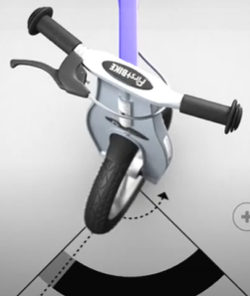 They are designed to minimize the degree of steering available on the bike.
They are designed to minimize the degree of steering available on the bike.
For example, FirstBike has a steering limiter that allows for approximately 90 degrees of steering (45 degrees in both directions from the neutral position). This option stops rider’s from over steering and may reduce potential falls. However, during a fall the handlebars will be left raised, providing a potential falling hazard to the rider.
We believe steering limiters are not necessary on a balance bike, as toddlers somewhat intuitively develop the correct bike handling and steering skills in their own time without this feature.
Footrests
Footrests, like other features, vary in their availability. Essentially, some bikes have them, some don’t.
They are designed to provide a safe platform for the rider to rest their feet when gliding.
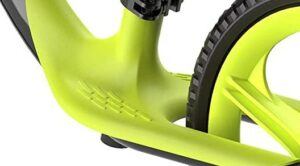 These are another, non-essential feature as toddlers will intuitively develop the ability to place their feet out of harm’s way toward the front or rear of their little bodies and even learn to rest these on the rear of the bike’s frame (where most footrests will be) as they become proficient at the art of gliding.
These are another, non-essential feature as toddlers will intuitively develop the ability to place their feet out of harm’s way toward the front or rear of their little bodies and even learn to rest these on the rear of the bike’s frame (where most footrests will be) as they become proficient at the art of gliding.
While not essential, we are a big fan of the better designed footrests that are discrete and positioned toward the rear of the frame, well away from where a rider’s little feet will be running.
Looking directly down over the seat from above, you should be able to see these well-designed footrests toward the back half of the bike’s saddle (see image).
Some better examples of well-designed footrests can be found on the GOMO, Strider 12 Sport, Vuly, Rolla, and Cooghi balance bikes.
8. Rider Characteristics and Personality
When considering which balance bike will best suit your child, this next point is crucial to consider. Our goal is to match your little rider with a balance bike that meets their unique needs and personalities. But why?
Well, not all balance bikes are created equal, and every rider is unique.
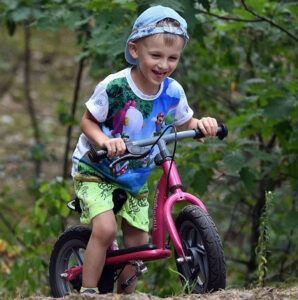 As a parent, no one will know your child better, so you are well prepared to consider which bike will suit your little rider best. Be sure to take into account their unique needs such as temperament, energy levels, personalities, interests, body size, unique physical needs and/or learning disabilities.
As a parent, no one will know your child better, so you are well prepared to consider which bike will suit your little rider best. Be sure to take into account their unique needs such as temperament, energy levels, personalities, interests, body size, unique physical needs and/or learning disabilities.
For example, if your child is a mini energizer bunny (you know the type), loves being outdoors, trying new sports or fun activities then a more expensive balance bike with air tires, handbrake and tank-like build would be a better choice.
The key here is this. Match the bike to your child, and not the child to the bike 🙂
9. Bike Quality and Warranty
As you have just read, bike features such as seat height adjustability, weight, tire choice, frame material and safety features such as a hand brake, steering limiter and footrests all help to determine the overall quality of a balance bike.
Balance bikes are no different to any other product. Essentially, you get what you pay for.
When talking kids balance bikes, the budget bikes have heavier frames, less adjustability options, foam tires, less safety features, and quite simply will not be of the same build quality as your higher end bikes.
Relatedly, the quality of the product will usually be reflected in the manufacturer’s warranty.
For example, the Cruzee Ultralight is a more expensive option, yet is covered by a generous lifetime warranty for the original owner. Whereas others may only include a 12- or 24-month limited warranty.
It’s always a good idea to check the warranty details of the bikes you are considering making sure these match your expectations.
10. Your Budget
Our final point we believe is best mentioned last as this relates directly to virtually every other piece of information parents should be aware of before purchasing a kid’s balance bike.
Let’s get straight to the point. Work out your budget first, your child’s unique skills and needs second, then consider the options available to you that aligns with both.
Here is a quick summary of our top three items parents should reflect upon when considering their balance bike budget.
1. Age and size of your child – if your child is around 2 years of age and tiny, they can potentially have 2+ years on the same balance bike. Therefore, you may wish to purchase a slightly better quality bike with excellent seat and handlebar adjustability.
2. Riding environment – if your child will mostly be riding indoors, or on hard flat surfaces then a cheaper bike with foam tires and no hand brake may suit their needs perfectly. On the other hand, if they will be riding mostly on off-road, hilly terrain then a bike with air tires and a hand brake would be beneficial.
3. Longevity and re-sale – quite simply, the cheaper the bike, the quicker it may become damaged from the rigors of your toddlers’ energetic adventures and the less re-sale value this will hold.
More expensive balance bikes may cost you more initially, however, hold their re-sale value better allowing you to get more money back from your investment to put towards your child’s next bike (but of course).
Conclusion
Well done!

If you are reading this, we commend you on your due diligence as you have just committed to spending some of your precious time investing in your child’s bike riding journey.
Your child is lucky to have you supporting their passions and encouraging them in what we like to call a developmental powerhouse of a toy, the kid’s balance bike.
Here’s a quick review of what you have just learnt.
1. How to know if your child is ready to ride
2. What is your child’s inseam height and how to find this
3. What is a balance bike’s seat height range and why this is important
4. How to find the correct bike weight for your child
5. Balance bike tire options and which is best
6. Balance bike frame materials
7. Safety features to consider
8. Rider characteristics and personality
9. Balance bike quality and warranty
10. Tips when considering your balance bike budget
If you would like to learn more about purchasing a kids balance bike, head over to our post Balance Bike Buyers Guide. You may also wish to check out our series on Which Balance Bike is Best For my Child. We are sure you will find these helpful.
Please feel free to leave any comments or questions below, we are here to help.
Happy riding!




As a parent who is considering a balance bike for my child, I found this article to be extremely informative. I particularly appreciated the emphasis on proper sizing and adjustable seats, as well as the recommendation to consider the child’s readiness. Overall, this article provided great guidance for anyone in the market for a balance bike and helped me make a more informed purchasing decision.
Hi Aly, thanks for your encouraging comments. We are so glad that you found our article helpful.
Our goal is to share our experience and expertise with our readers, so you can confidently know everything you need to before purchasing a balance bike that is best suited for your child.
We encourage you to look around our website as you may find other posts very helpful and if you know of anyone else who may benefit from our website, please share this with them.
Also feel free to send us any questions that you may have, as we enjoy hearing about your riding experiences. Happy riding!
I believe that balance bikes are an excellent tool for children to learn how to balance and coordinate their movements. They can be a great alternative to traditional training wheels, which may not provide the same level of support for learning balance.
I agreed that balance bikes can be used by children as young as 18 months old. While this may be true, it’s important for parents to consider their child’s individual development and abilities before introducing a balance bike. Some children may not be ready to use a balance bike until they are closer to two years old or even older.
How do you recommend parents choose the right type of balance bike for their child, considering factors such as height, weight, and skill level?
Hi Maxon,
Thanks for sending through your comments. We really appreciate hearing from you and enjoy helping our readers as best we can.
To answer your questions, when considering height, weight and skill level, these three factors should be reflected upon as follows.
1. Height – this will mainly govern the child’s seat height. Just like our article states, measuring your child’s inseam is paramount. Then, make sure the bike has the correct seat height range to accommodate the child’s inseam
2. Weight – refer to our post that gives you a great rule to follow. the bike should not weigh more than 30% of the child’s weight.
3. Skill level – most toddlers starting out on a balance bike will be literally taking their first steps on a bike. Balance bikes are designed for beginners and to help them learn the correct bike riding skills of balance, coordination and steering at their own pace. All balance bikes, as long as they are the correct fit, will be fine to begin this riding journey.
I hope this helps you. Please feel free to ask any further questions and share our site with other’s you think may benefit from learning more about balance bikes.
Happy riding!
Recently, my friend’s child is going to have a birthday, and I’m still wondering what to buy for her.
This article provides all the things you should pay attention to when buying a balance bike!!
I think I can buy it with confidence, there will be no mistakes.
In addition, a balance bike is also very practical for children’s development!
Thanks for sharing
Hi Winter, thank you for taking the time to read our post and send through your comments.
We value your time and thoughts and are glad you found our post helpful.
Yes, that’s right. A balance bike is a wonderful developmental powerhouse of a toy! The benefits are extraordinary and overall, it’s such an amazing outlet for little toddlers to learn so many healthful skills.
You may wish to check out our post,
Balance Bike Buyers Guide – ilovetoridemybike
The above post has everything you will need to know before going balance bike shopping.
If you have any further questions, feel free to send me a message. Best of luck with our purchase. They will be one lucky little child to receive such a brilliant gift.
Happy riding!